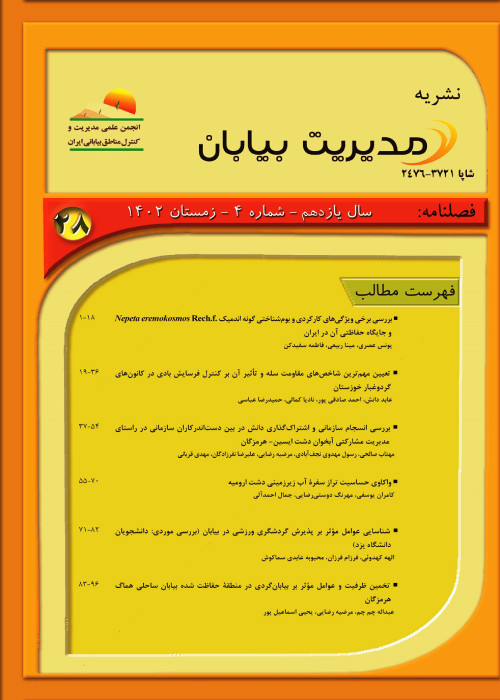Influence of Different Land Uses on Some Soil Microbial Indices (Case Study: Lasjerd, Semnan Province, Iran)
Widespread lands in arid, semi-arid, or dry sub-humid areas of the world have been influenced by the consequences of the land degradation resulting from natural factors and human activities like agriculture, changes in the land use. A large part of Iran is located in arid and semi-arid regions. The degradation of soil can be greatly impacted by agricultural activities, incorrect management, and improper land management. The most suitable solution to reduce the negative effects of land use change on the desert is to choose the best type of land management with the least degradation. The fragile nature of these ecosystems and the large area of arid and semi-arid areas of the country require proper and accurate management. Soil is an important and valuable terrestrial source of OC storage, which plays a significant role in the global C cycle by storing about 1500 billion tons of C. The total C in microbial biomass is 1.4% of the total SOC. demonstrating the significant contribution of this sector to the global C cycle. Land use change can be one of the most important factors of land degradation that affects the quality and quantity of soil organic C, and soil characteristics. The present study was done to investigate the role of different land uses including rangeland as control, abandoned land, Triticum aestivum L. cultivation, Hordeum vulgare L. cultivated lands and Medicago sativa L. cultivation, on some soil microbial indices such as basal soil respiration, substrate induced respiration, microbial biomass carbon, microbial biomass nitrogen, microbial quotient, metabolic coefficient and carbon access index, in Lasjerd , Semnan province in two depths of 0 to 10 cm and 10 to 30 cm.
The initial step was to select various treatments that included rangeland as control treatment, abandoned land, Triticum aestivum cultivation, Hordeum vulgare cultivated lands and Medicago sativa cultivation. In the second step, soil sampling was performed at two depths of 0-10 and 10-30 cm in five replications. In this regard, one soil profile in the center and four other profiles were dug in the form of a cross, considering the marginal effect. The samples needed for soil biological tests were carried and stored in the refrigerator containing dry ice and biological tests were performed later. The considered factors were measured by valid scientific guidelines and methods. Data related to soil microbial properties were analyzed by a factorial test in the form of a completely random design with five repetitions. All statistical computing was done using SPSS 19 software and the mean comparison tests were performed by Duncan test.
The results of the present study indicated that there is significant impact of the treatments on the properties studied at the two depths, at the first soil layer equals to the depth of 0 to 10 cm, basal soil respiration, substrate induced respiration, microbial biomass carbon, microbial biomass nitrogen, microbial quotient, and metabolic coefficient have been affected by different land uses, as the highest level of basal soil respiration in the abandoned land equals to 0.424 mgCO2g-1dm24h-1 and the lowest in Triticum aestivum cultivation 0.006 mgCO2g-1dm24h-1, as well as the second depth- 10 to 30 cm- basal soil respiration, microbial quotient, metabolic coefficient are affected by different types of land uses. The highest amount of metabolic coefficient was observed in abandoned lands as 0.068 mgCO2 C1MBCday-1 and the lowest was found in Medicago sativa cultivation lands equals to 0.013 mgCO2-Cg-1MBCday-1. Soil microbial indices are sensitive to land use changes. The first top 10 cm of the soil studied, has been most affected by these indices. Due to the failure of soil pedons, the change in land use from rangeland to agricultural lands increases the speed of litter decomposition and decreases the storage of soil nutrients, the microbial population, composition and activity of the soil as an indicator of soil quality, health and fertility. But techniques of no-tillage or minimal-tillage, as well as the principles of sustainable agriculture (such as returning the residues to the soil, proper use of chemical fertilizers, using biological fertilizers, and biological control of pests) cause the destructive process of the biological indices to be adjusted and get balanced in a shorter time period with environment. Considering the changes in the biological indicators of the soil, which have caused the destruction of the cultivated lands in the studied area, it is suggested to rehabilitate the bare lands with native rangeland species of the region, such as Artemisia sieberi Besser, Zygophyllum eurypterum Boiss. & Buhse, and Astragalus tribuloides Delile. Range management plans are the only way to allocate rangelands in the region, and a detailed survey of rangelands in the region is necessary. To prevent land use change, it is important to address the multi-purpose uses of rangelands and the determination of economic units to support the lives of beneficiary households.
- حق عضویت دریافتی صرف حمایت از نشریات عضو و نگهداری، تکمیل و توسعه مگیران میشود.
- پرداخت حق اشتراک و دانلود مقالات اجازه بازنشر آن در سایر رسانههای چاپی و دیجیتال را به کاربر نمیدهد.



